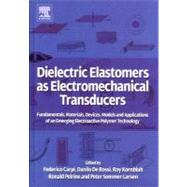Dielectric Elastomers as Electromechanical Transducers
, by Carpi; De Rossi; Kornbluh; Pelrine; Sommer-Larsen- ISBN: 9780080474885 | 0080474888
- Cover: Hardcover
- Copyright: 3/10/2008
This book describes one of the most promising classes of polymer-based smart materials and technologies for electromechanical transducers and "pseudo-muscular" actuation devices to be used in a very broad range of applications, spanning from robotics and automation to the biomedical field. This class of materials, known as "dielectric elastomers", belong to the larger family of so-called ElectroActive Polymers (EAP), currently being developed and studied as "artificial muscles". Dielectric elastomer actuation is drawing a particular interest because of its promise of simple and robust low-cost devices with overall performance exceeding most conventional technologies, such as electromagnetics and piezoelectrics. In fact, dielectric elastomer actuators have demonstrated strain and energy density exceeding that of all high-speed field-activated actuation technologies. Further, in addition to actuation, dielectric elastomers have also been shown to offer unique possibilities for improved generator and sensing devices. Dielectric elastomer transduction was introduced during the 1990s, pioneered by SRI International. Although the field is still being explored and expanded extensively, a great deal of work has already been done, with encouraging results. This technology is enabling today an enormous range of applications that were not possible with any other EAP or smart-material technology until a few years ago. For interested readers, this book is expected to provide a comprehensive and updated insight on this technology. The book covers all the fundamental aspects, comprising a collection of chapters written by the fathers of this technology, along with the most renowned international contributors in the field. The presented topics range from transduction principles, basic materials properties, design of devices, material and device modelling, up to possible applications and future research avenues. Such an extension of the covered topics is expected to make this text as the first reference handbook on dielectric elastomer transduction. Book jacket.






